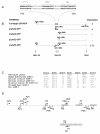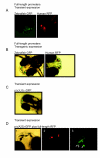In silico and in situ characterization of the zebrafish (Danio rerio) gnrh3 (sGnRH) gene
- PMID: 12188930
- PMCID: PMC126252
- DOI: 10.1186/1471-2164-3-25
In silico and in situ characterization of the zebrafish (Danio rerio) gnrh3 (sGnRH) gene
Abstract
Background: Gonadotropin releasing hormone (GnRH) is responsible for stimulation of gonadotropic hormone (GtH) in the hypothalamus-pituitary-gonadal axis (HPG). The regulatory mechanisms responsible for brain specificity make the promoter attractive for in silico analysis and reporter gene studies in zebrafish (Danio rerio).
Results: We have characterized a zebrafish [Trp7, Leu8] or salmon (s) GnRH variant, gnrh3. The gene includes a 1.6 Kb upstream regulatory region and displays the conserved structure of 4 exons and 3 introns, as seen in other species. An in silico defined enhancer at -976 in the zebrafish promoter, containing adjacent binding sites for Oct-1, CREB and Sp1, was predicted in 2 mammalian and 5 teleost GnRH promoters. Reporter gene studies confirmed the importance of this enhancer for cell specific expression in zebrafish. Interestingly the promoter of human GnRH-I, known as mammalian GnRH (mGnRH), was shown capable of driving cell specific reporter gene expression in transgenic zebrafish.
Conclusions: The characterized zebrafish Gnrh3 decapeptide exhibits complete homology to the Atlantic salmon (Salmo salar) GnRH-III variant. In silico analysis of mammalian and teleost GnRH promoters revealed a conserved enhancer possessing binding sites for Oct-1, CREB and Sp1. Transgenic and transient reporter gene expression in zebrafish larvae, confirmed the importance of the in silico defined zebrafish enhancer at -976. The capability of the human GnRH-I promoter of directing cell specific reporter gene expression in zebrafish supports orthology between GnRH-I and GnRH-III.
Figures





References
-
- Sherwood N. Evolution of a neuropeptide family, Gonadotropin-releasing hormone. Amer Zool. 1986. pp. 1041–1054.
-
- Seeburg PH, Mason AJ, Stewart TA, Nikolics K. The mammalian GnRH gene and its pivotal role in reproduction. Recent Prog Horm Res. 1987;43:69–98. - PubMed
-
- King JA, Millar RP. Gonadotropin-Releasing hormones. In: Pang PKT, Schreibman MP, editor. Vertebrate Endocrinology: Fundamental and Biomedical Implications. Orlando, Academic Press; 1991. pp. 1–33.
-
- Amano M, Oka Y, Aida K, Okumoto N, Kawashima S, Hasegawa Y. Immunocytochemical demonstration of salmon GnRH and chicken GnRH-II in the brain of masu salmon, Oncorhynchus masou. J Comp Neurol. 1991;314:587–597. - PubMed
-
- Bailhache T, Arazam A, Klungland H, Alestrom P, Breton B, Jego P. Localization of salmon gonadotropin-releasing hormone mRNA and peptide in the brain of Atlantic salmon and rainbow trout. J Comp Neurol. 1994;347:444–454. - PubMed
LinkOut - more resources
Full Text Sources
Molecular Biology Databases

